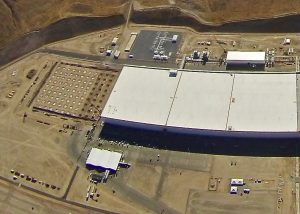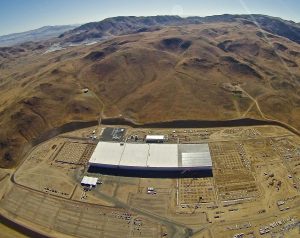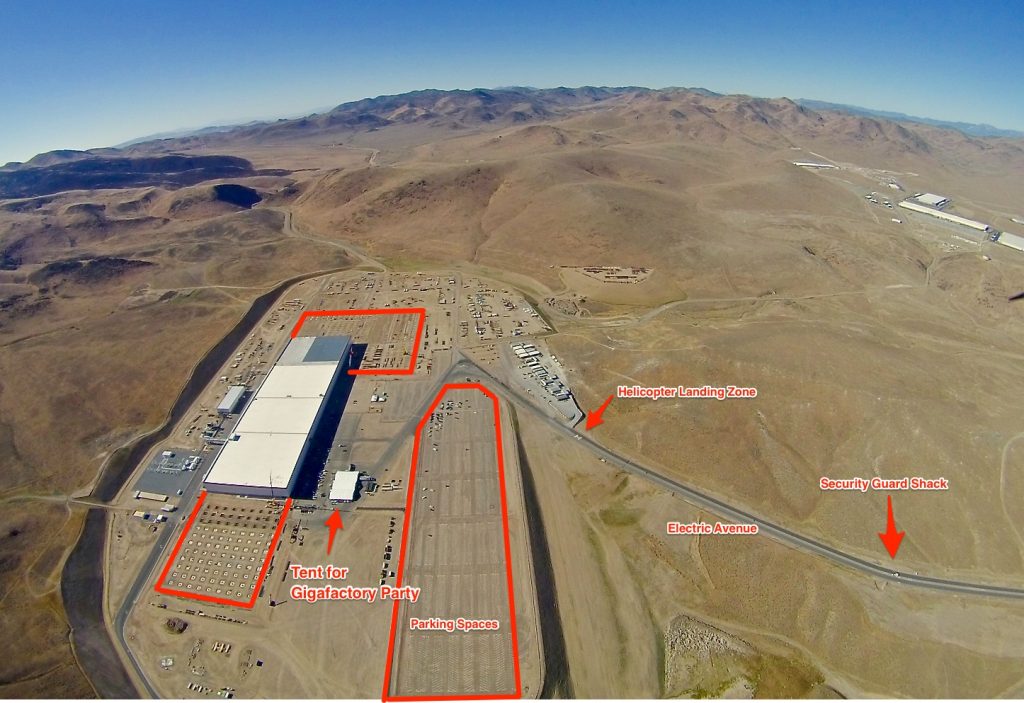News
[Photos] Preparations for Tesla’s Gigafactory event are well underway
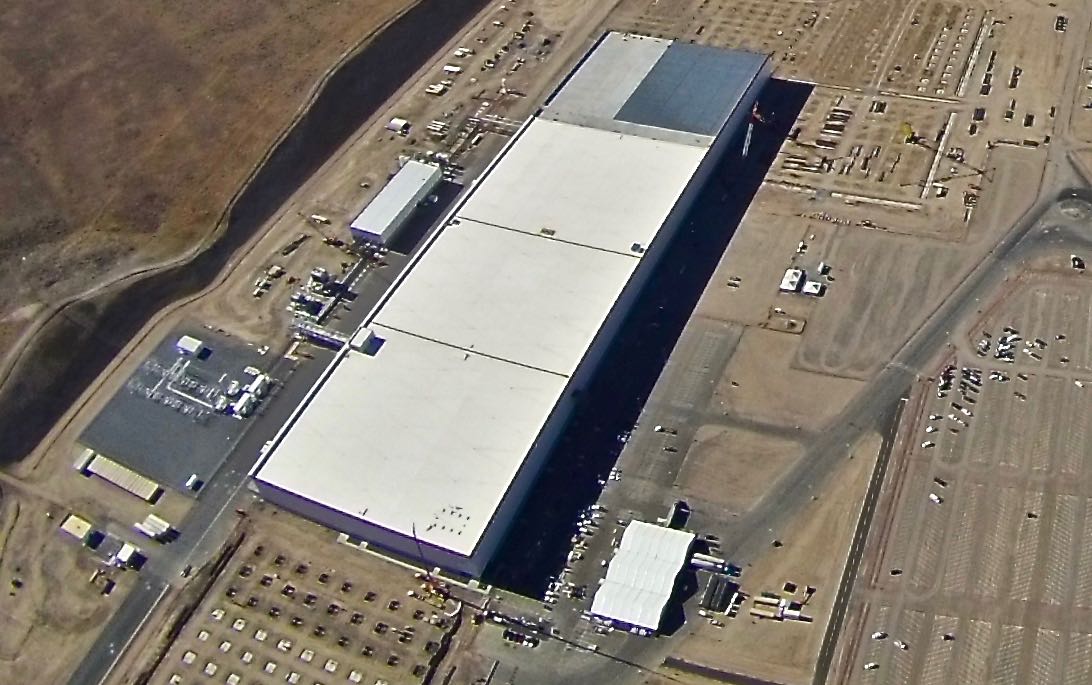
New aerial photos obtained by Teslarati show party preparations for Tesla’s upcoming July 29 Gigafactory event are well underway. Photos of Tesla’s $5 billion high-tech battery plant located 20 miles east of Reno, Nevada reveal that the electric automaker turned energy company has perched a large white tent off the main road, rightfully named Electric Avenue, that leads into the Gigafactory.
Several tractor trailers are seen surrounding the tent with a pair of trailers positioned in a way that would suggest cargo was being unloaded into the tent. Taking into account that commercial tractor trailers are generally 53 feet in length, we approximate the tent to be about 210 feet in length and 105 feet wide, or twice the size of a professional NBA basketball court.
- Tesla Gigafactory event prepartions seen in aerial photo
- A newly perched white tent is seen near the entrance to the Gigafactory
- Tesla Gigafactory, July 24, 2016
Also seen in the photos taken on Sunday, July 24 by local flight instructor Josh Mcdonald are roughly 2,000 newly painted parking spaces located directly west of Tesla’s Gigafactory 1. Tesla will be providing valet parking for those driving to Gigafactory 1 via Electric Avenue, but will also have shuttle service departing from downtown Reno to the battery plant. Though Tesla has not disclosed the planned attendance figure for the highly anticipated event, we know CEO Elon Musk isn’t one to shy away from throwing a good party. Both the Tesla ‘D event’ and the Model X unveiling each drew between 4,000 – 6,000 in attendance.
Looking forward to the Gigafactory opening party on Friday next week. The scale blows me away every time I see it.
— Elon Musk (@elonmusk) July 22, 2016
Tesla will also be providing factory tours of Gigafactory 1 as well as “test rides” according to event details outlined on the company’s official invitation to the July 29 party. There’s been speculation that Tesla will be providing event attendees rides in the final version of the Model 3 which completed design late last month.
We know that Musk has said in the past that Tesla will “do the obvious thing” regarding Autopilot on the Model 3. Contrary to Tesla’s current semi-autonomous driving feature which has seen its share of negative press after the first fatality occurred behind the wheel of a Model S on Autopilot, many believe that the obvious thing in this case is a fully autonomous vehicle capable of driving on its own with no human intervention.
Looking at a close up of the area near the white tent, we can see a section leading to a paved road that runs alongside the expansive parking lot, and around the outer perimeter of the factory lot. Zooming into the photo even more and you can see the paved road is painted with very clear lane markings, perhaps to ensure that Autopilot 2.0 sensors have all of the cues needed for a successful demo. What we’re seeing here might in fact be a test track where rides will take place.
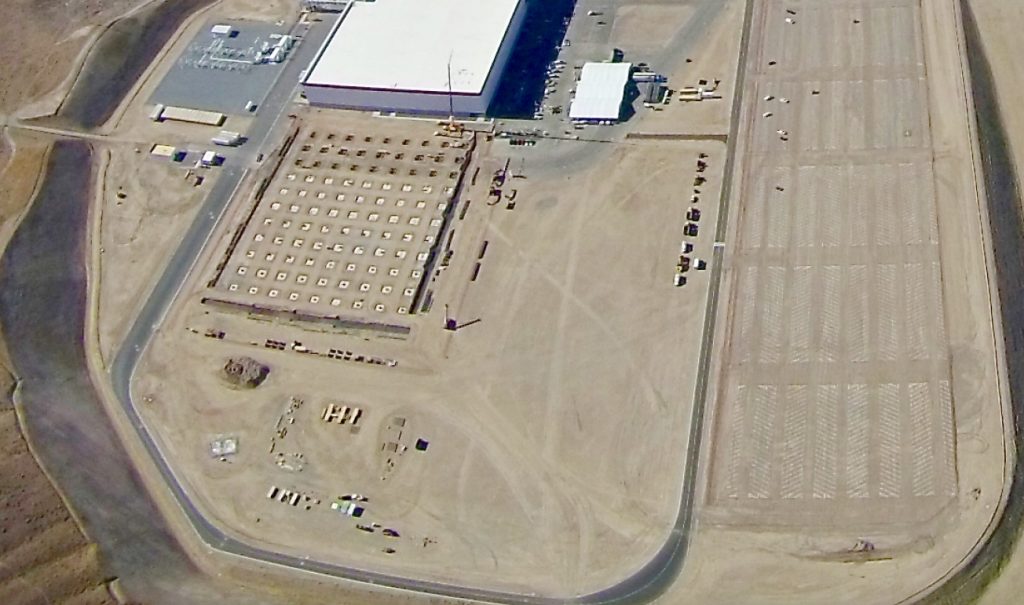
Test rides might be originating from near the white tent and on the paved road surrounding the outer perimeter of the Gigafactory 1 lot.
Musk’s vision for the future includes the use of Tesla’s battery plant as the supplier of li-ion cells for its upcoming fleet of Tesla trucks, semis and home and commercial energy solutions.
Tesla broke ground on its first Gigafactory in June 2014 and is expected to produce 105 gigawatt hours of battery cells when it reaches full production in 2020, and becomes the world’s largest producer and consumer of li-ion battery cells.
The four completed sections of the Gigafactory to date represents only 15% of the overall total size when completed. Josh Mcdonald of Nevada Tailwheel tells us, “Tesla has begun construction on the next phase of the Gigafactory as seen from the newly graded sections with concrete and steel pylons forming the base of the foundation directly to the north and south of the factory”.
We’ve outlined in red a few key areas of the Gigafactory seen from the aerial photo. Among the areas outlined are new sections north and south of the existing building, a helicopter landing zone and the security guard shack on Electric Avenue.
News
Tesla launches in India with Model Y, showing pricing will be biggest challenge
Tesla finally got its Model Y launched in India, but it will surely come at a price for consumers.

Tesla has officially launched in India following years of delays, as it brought its Model Y to the market for the first time on Tuesday.
However, the launch showed that pricing is going to be its biggest challenge. The all-electric Model Y is priced significantly higher than in other major markets in which Tesla operates.
On Tuesday, Tesla’s Model Y went up for sale for 59,89,000 rupees for the Rear-Wheel Drive configuration, while the Long Range Rear-Wheel Drive was priced at 67,89,000.
This equates to $69,686 for the RWD and $78,994 for the Long Range RWD, a substantial markup compared to what these cars sell for in the United States.
🚨 Here’s the difference in price for the Tesla Model Y in the U.S. compared to India.
🚨 59,89,000 is $69,686
🚨 67,89,000 is $78,994 pic.twitter.com/7EUzyWLcED— TESLARATI (@Teslarati) July 15, 2025
Deliveries are currently scheduled for the third quarter, and it will be interesting to see how many units they can sell in the market at this price point.
The price includes tariffs and additional fees that are applied by the Indian government, which has aimed to work with foreign automakers to come to terms on lower duties that increase vehicle cost.
Tesla Model Y seen testing under wraps in India ahead of launch
There is a chance that these duties will be removed, which would create a more stable and affordable pricing model for Tesla in the future. President Trump and Indian Prime Minister Narendra Modi continue to iron out those details.
Maharashtra Chief Minister Devendra Fadnavis said to reporters outside the company’s new outlet in the region (via Reuters):
“In the future, we wish to see R&D and manufacturing done in India, and I am sure at an appropriate stage, Tesla will think about it.”
It appears to be eerily similar to the same “game of chicken” Tesla played with Indian government officials for the past few years. Tesla has always wanted to enter India, but was unable to do so due to these import duties.
India wanted Tesla to commit to building a Gigafactory in the country, but Tesla wanted to test demand first.
It seems this could be that demand test, and the duties are going to have a significant impact on what demand will actually be.
Elon Musk
Tesla ups Robotaxi fare price to another comical figure with service area expansion
Tesla upped its fare price for a Robotaxi ride from $4.20 to, you guessed it, $6.90.

Tesla has upped its fare price for the Robotaxi platform in Austin for the first time since its launch on June 22. The increase came on the same day that Tesla expanded its Service Area for the Robotaxi ride-hailing service, offering rides to a broader portion of the city.
The price is up from $4.20, a figure that many Tesla fans will find amusing, considering CEO Elon Musk has used that number, as well as ’69,’ as a light-hearted attempt at comedy over the past several years.
Musk confirmed yesterday that Tesla would up the price per ride from that $4.20 point to $6.90. Are we really surprised that is what the company decided on, as the expansion of the Service Area also took effect on Monday?
But the price is now a princely $6.90, as foretold in the prophecy 😂
— Elon Musk (@elonmusk) July 14, 2025
The Service Area expansion was also somewhat of a joke too, especially considering the shape of the new region where the driverless service can travel.
I wrote yesterday about how it might be funny, but in reality, it is more of a message to competitors that Tesla can expand in Austin wherever it wants at any time.
Tesla’s Robotaxi expansion wasn’t a joke, it was a warning to competitors
It was only a matter of time before the Robotaxi platform would subject riders to a higher, flat fee for a ride. This is primarily due to two reasons: the size of the access program is increasing, and, more importantly, the service area is expanding in size.
Tesla has already surpassed Waymo in Austin in terms of its service area, which is roughly five square miles larger. Waymo launched driverless rides to the public back in March, while Tesla’s just became available to a small group in June. Tesla has already expanded it, allowing new members to hail a ride from a driverless Model Y nearly every day.
The Robotaxi app is also becoming more robust as Tesla is adding new features with updates. It has already been updated on two occasions, with the most recent improvements being rolled out yesterday.
Tesla updates Robotaxi app with several big changes, including wider service area
News
Tesla Model Y and Model 3 dominate U.S. EV sales despite headwinds
Tesla’s two mainstream vehicles accounted for more than 40% of all EVs sold in the United States in Q2 2025.

Tesla’s Model Y and Model 3 remained the top-selling electric vehicles in the U.S. during Q2 2025, even as the broader EV market dipped 6.3% year-over-year.
The Model Y logged 86,120 units sold, followed by the Model 3 at 48,803. This means that Tesla’s two mainstream vehicles accounted for 43% of all EVs sold in the United States during the second quarter, as per data from Cox Automotive.
Tesla leads amid tax credit uncertainty and a tough first half
Tesla’s performance in Q2 is notable given a series of hurdles earlier in the year. The company temporarily paused Model Y deliveries in Q1 as it transitioned to the production of the new Model Y, and its retail presence was hit by protests and vandalism tied to political backlash against CEO Elon Musk. The fallout carried into Q2, yet Tesla’s two mass-market vehicles still outsold the next eight EVs combined.
Q2 marked just the third-ever YoY decline in quarterly EV sales, totaling 310,839 units. Electric vehicle sales, however, were still up 4.9% from Q1 and reached a record 607,089 units in the first half of 2025. Analysts also expect a surge in Q3 as buyers rush to qualify for federal EV tax credits before they expire on October 1, Cox Automotive noted in a post.
Legacy rivals gain ground, but Tesla holds its commanding lead
General Motors more than doubled its EV volume in the first half of 2025, selling over 78,000 units and boosting its EV market share to 12.9%. Chevrolet became the second-best-selling EV brand, pushing GM past Ford and Hyundai. Tesla, however, still retained a commanding 44.7% electric vehicle market share despite a 12% drop in in Q2 revenue, following a decline of almost 9% in Q1.
Incentives reached record highs in Q2, averaging 14.8% of transaction prices, roughly $8,500 per vehicle. As government support winds down, the used EV market is also gaining momentum, with over 100,000 used EVs sold in Q2.
Q2 2025 Kelley Blue Book EV Sales Report by Simon Alvarez on Scribd
-

 News3 days ago
News3 days agoTesla debuts hands-free Grok AI with update 2025.26: What you need to know
-

 Elon Musk1 week ago
Elon Musk1 week agoElon Musk confirms Grok 4 launch on July 9 with livestream event
-

 Elon Musk6 days ago
Elon Musk6 days agoxAI launches Grok 4 with new $300/month SuperGrok Heavy subscription
-

 News2 weeks ago
News2 weeks agoTesla Model 3 ranks as the safest new car in Europe for 2025, per Euro NCAP tests
-

 Elon Musk2 weeks ago
Elon Musk2 weeks agoxAI’s Memphis data center receives air permit despite community criticism
-

 News5 days ago
News5 days agoTesla begins Robotaxi certification push in Arizona: report
-

 Elon Musk2 weeks ago
Elon Musk2 weeks agoTesla reveals it is using AI to make factories more sustainable: here’s how
-

 Elon Musk2 weeks ago
Elon Musk2 weeks agoTesla scrambles after Musk sidekick exit, CEO takes over sales


